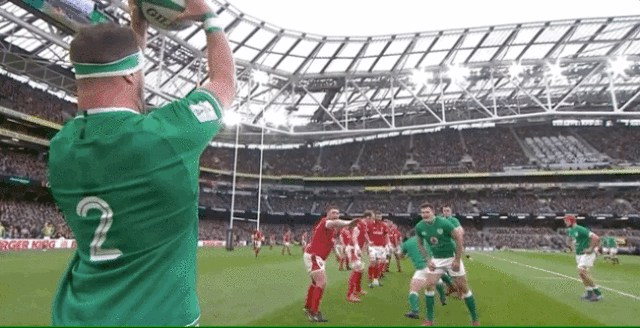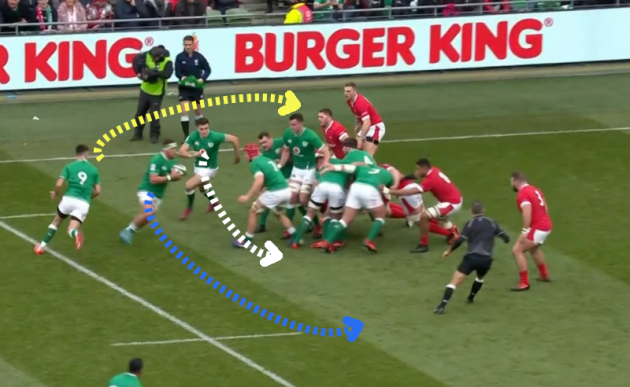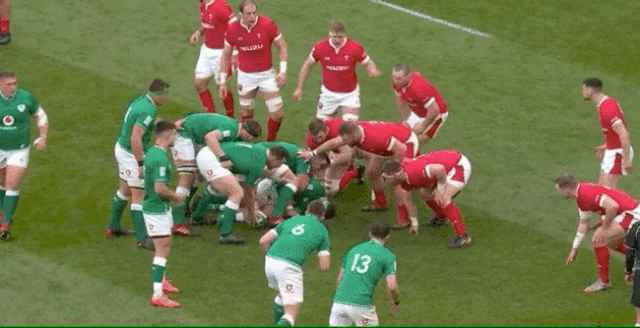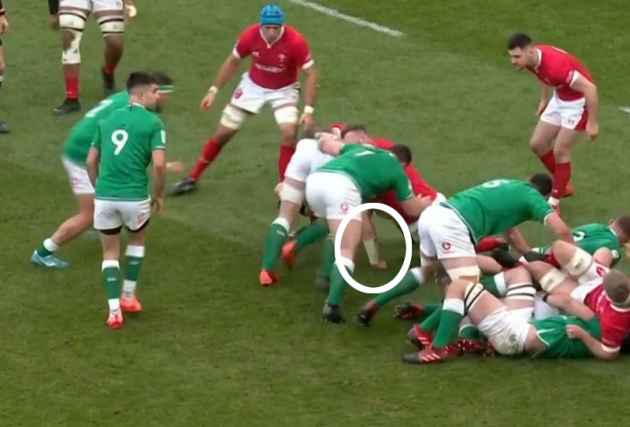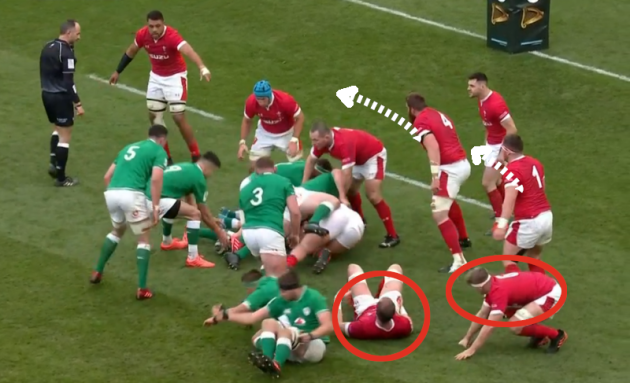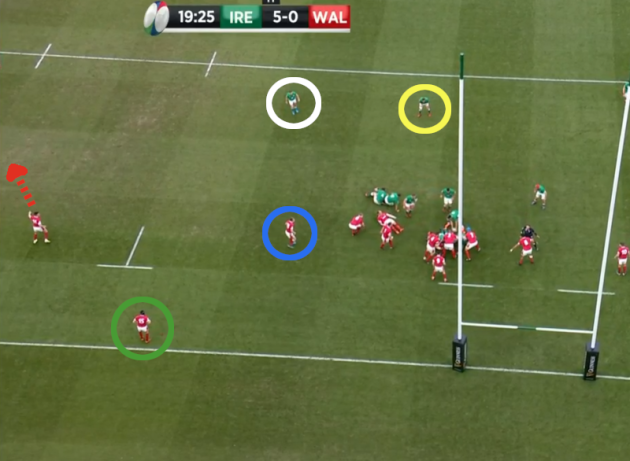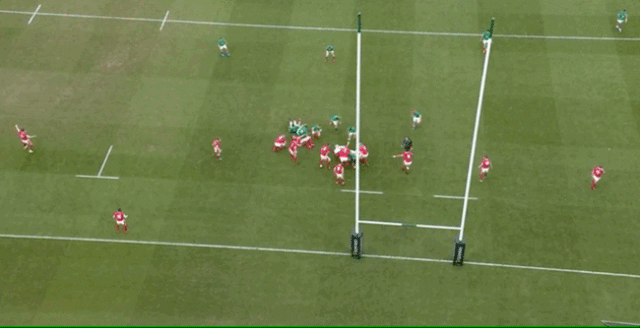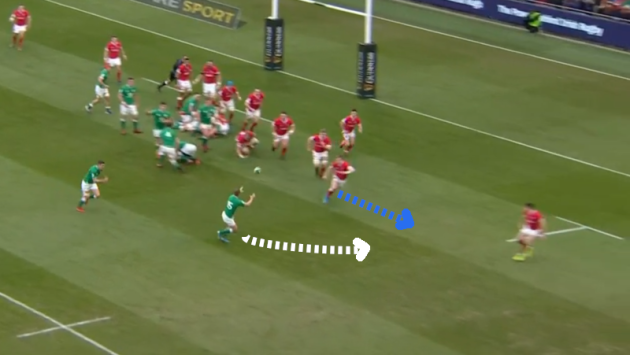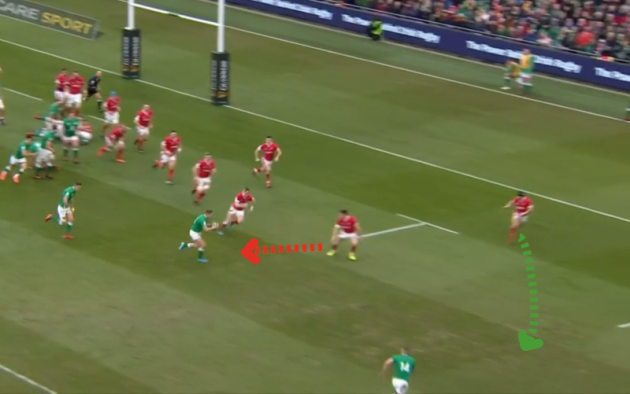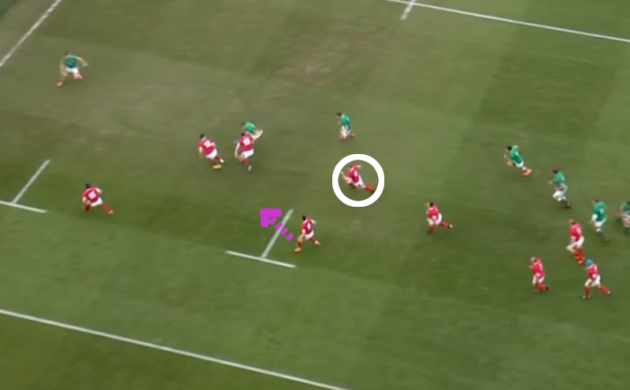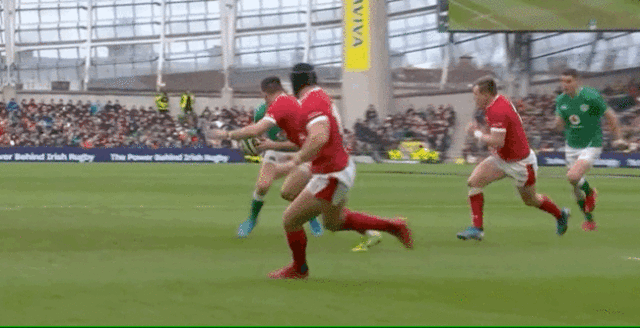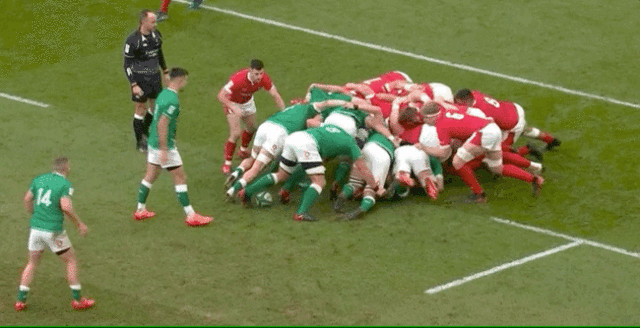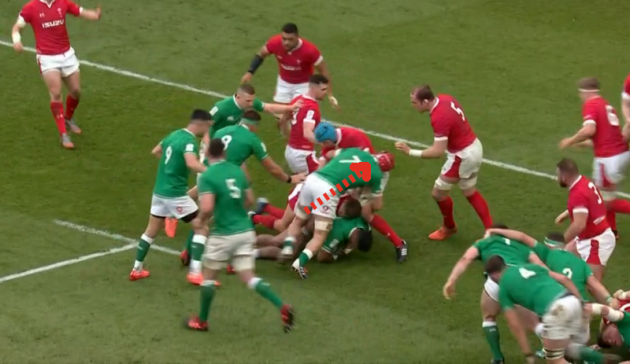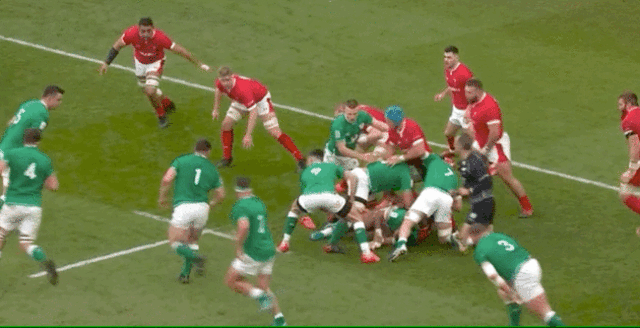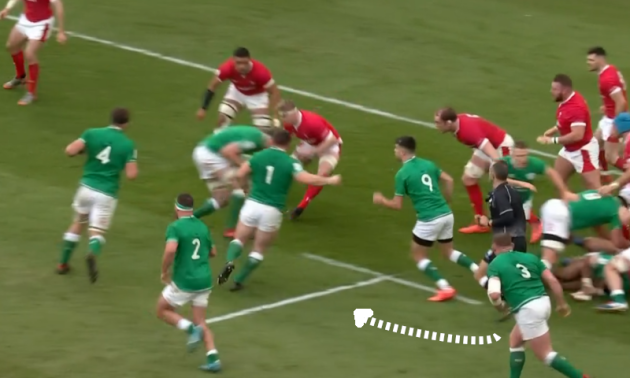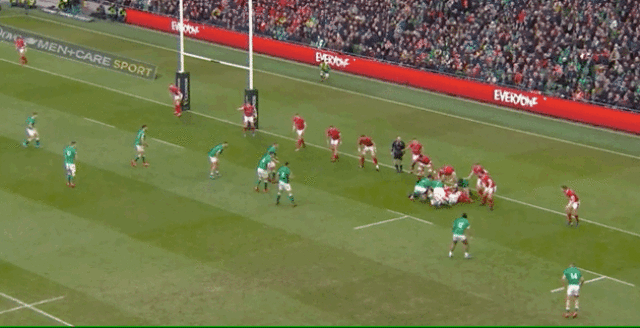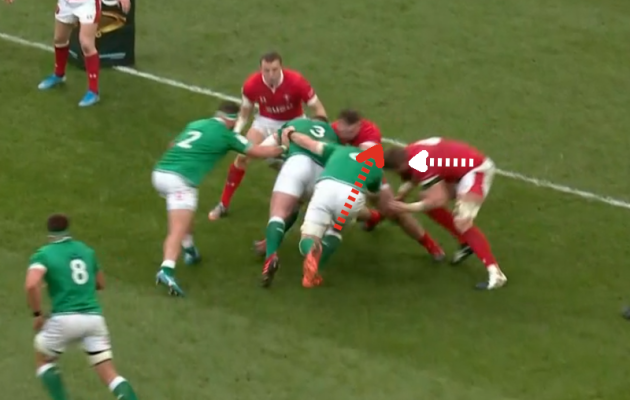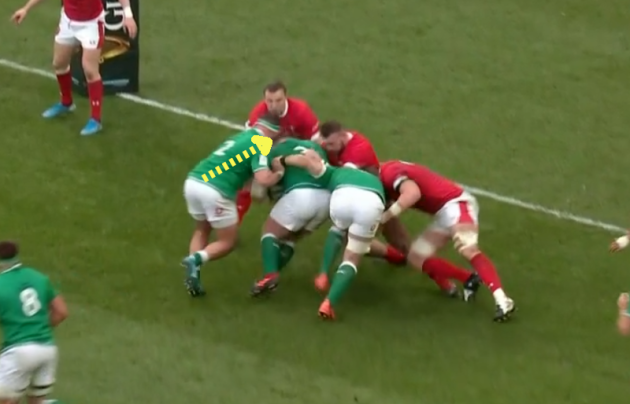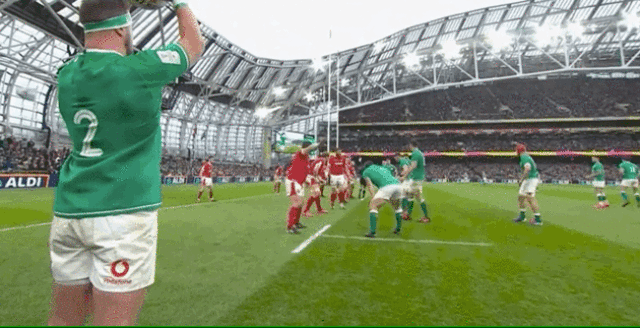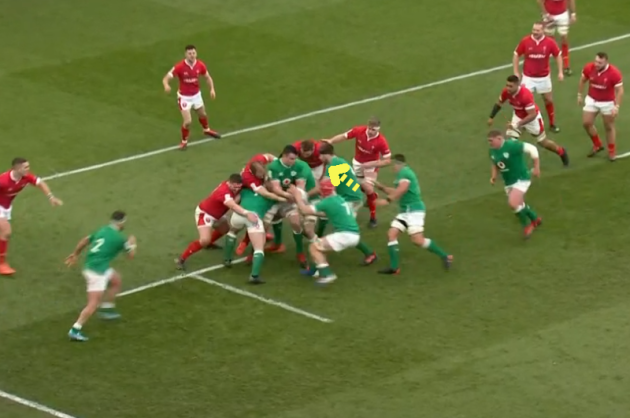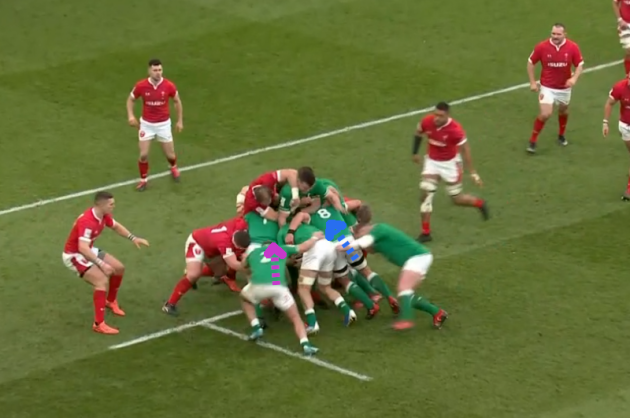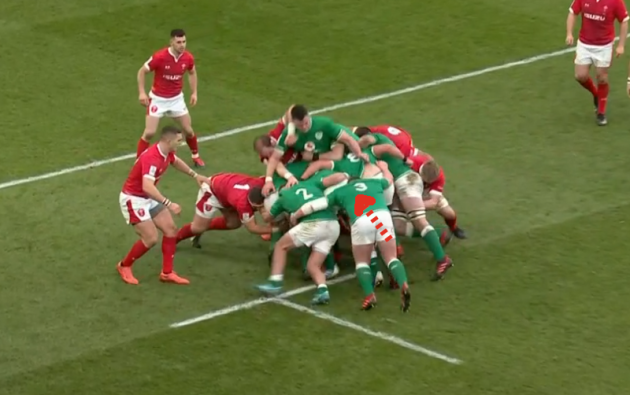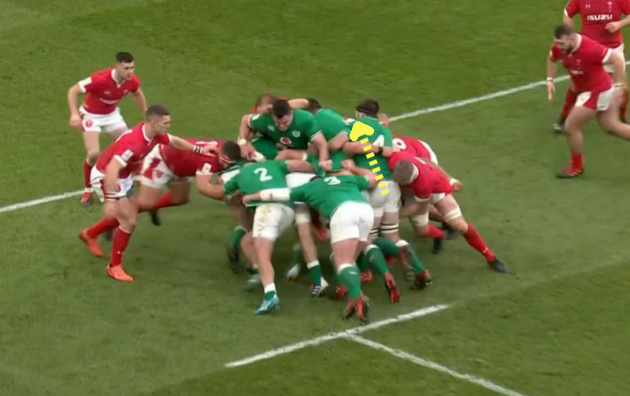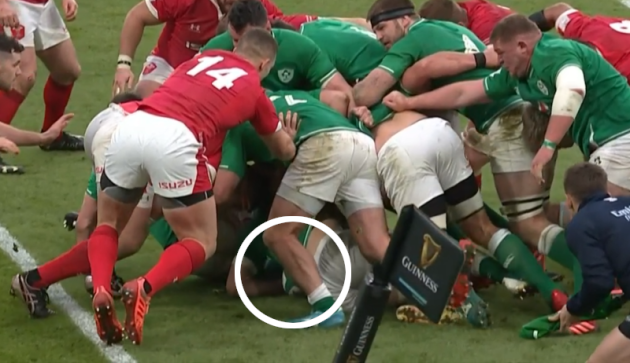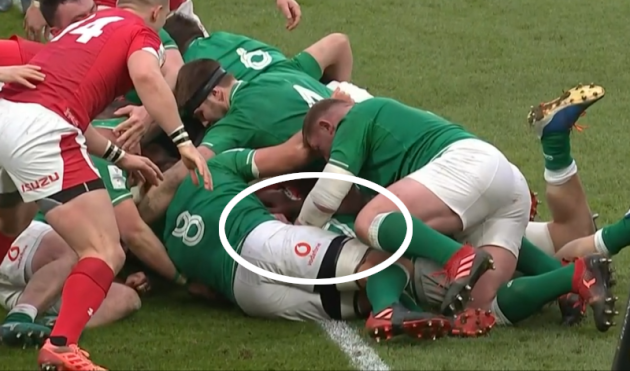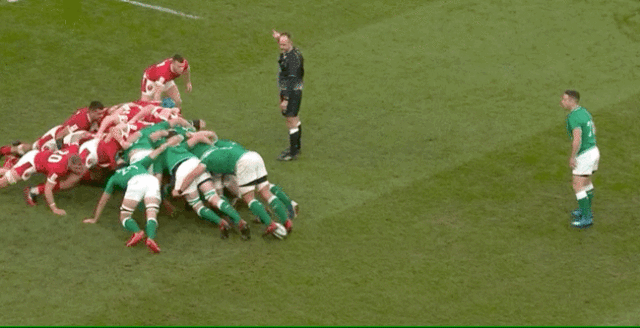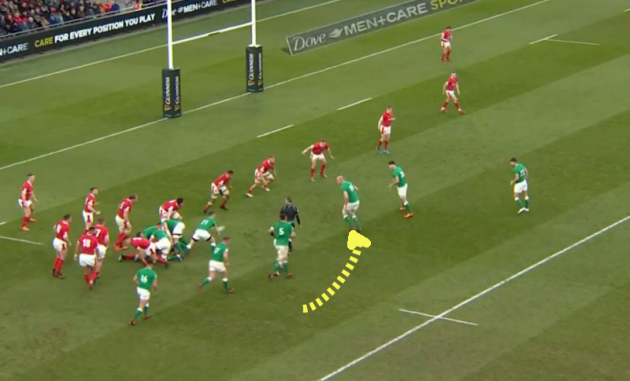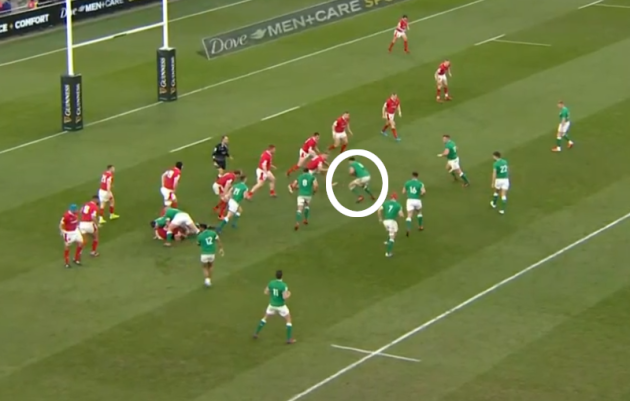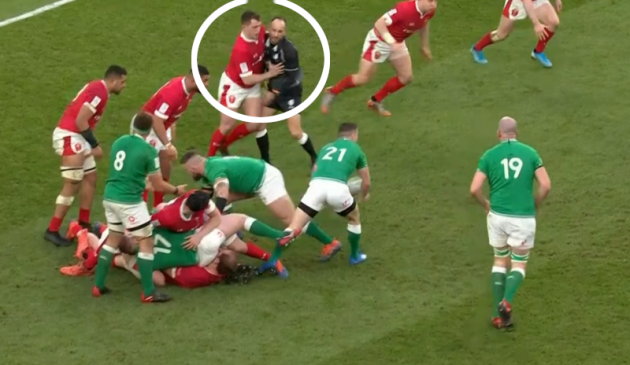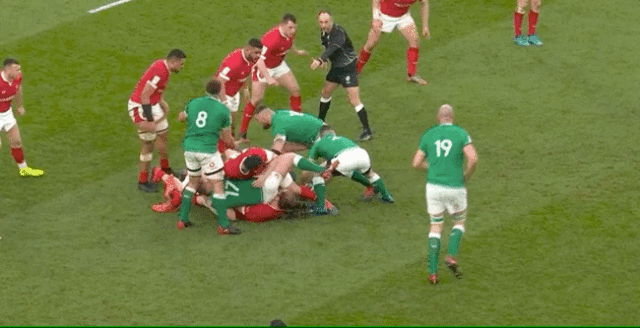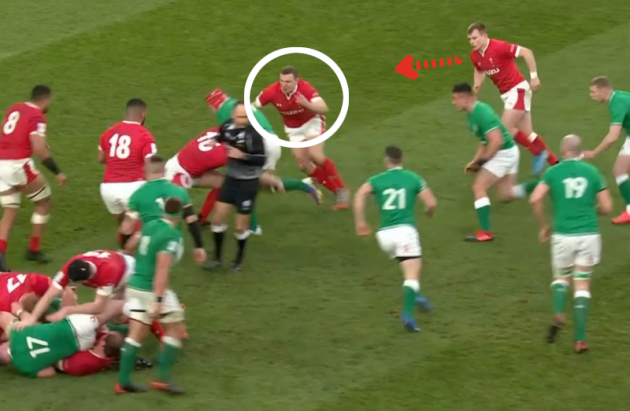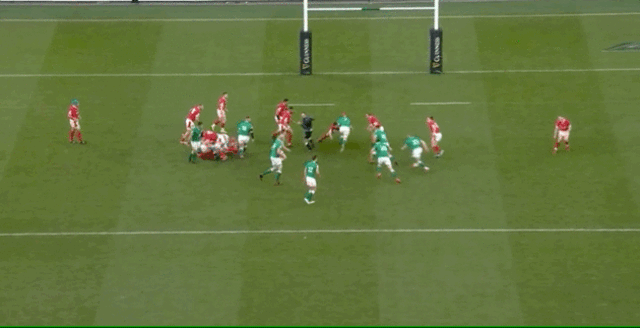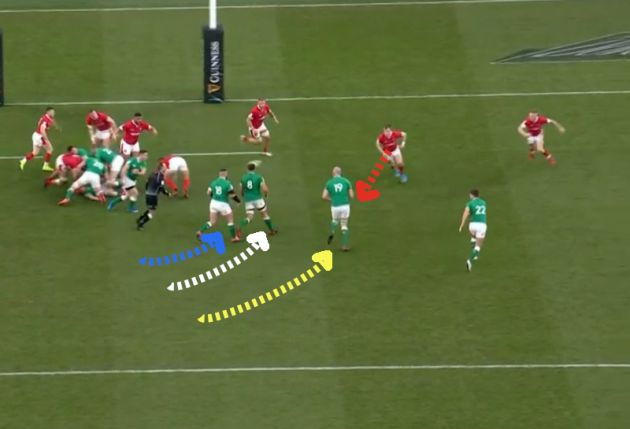AN ENCOURAGING PERFORMANCE from Ireland in Dublin yesterday leaves plenty of room for more improvement in the weeks ahead in this Six Nations.
Andy Farrell’s men had 10 visits into the Wales 22 in this game but came up empty-handed on six of those occasions.
While teams cannot realistically expect to have a 100% return from their 22 visits, earning scores when occupying this area of the pitch is obviously vitally important.
A 40% return won’t have greatly pleased Farrell and his players but those four successful stints in the 22 did show Ireland at their clinical and composed best. The challenge is to ensure the try-scoring visits are increasingly the norm.
Ireland’s opening three visits into the Wales 22 yesterday left them frustrated as they were penalised at a five-metre scrum, saw Wyn Jones win a breakdown penalty, then had their maul turned over just metres short – a decision captain Johnny Sexton clearly didn’t feel was correct.
But visit number four was a success as Ireland launched off a left-hand side lineout.
The initial play is a smart one.
[Click here if you cannot view the clip above]
The unorthodox lineout set-up gives us a hint that Ireland have something different planned here.
Left wing Jacob Stockdale is at the front of the lineout, while scrum-half Conor Murray is at the very tail of the lineout. Openside Josh van der Flier starts in the ‘receiver’ position behind the lineout, the idea being to suggest to Wales that Ireland will maul.
James Ryan wins the ball and transfers it to van der Flier, who then turns to hit hooker Rob Herring [blue below] coming off the touchline as Murray [yellow] and Stockdale [white] are also in motion.
The scrum-half works down into the shortside, looking to fix the two defenders in that channel. Meanwhile, Stockdale works to the right, trailing the run of Herring on the inside but remaining hidden until a late stage.
There is a real chance here for Herring to hit Stockdale [white below] with an inside pass as the two Welsh fringe defenders track him. Stockdale would have backed himself to break any reactionary tackle from Taulupe Faletau turning back in and potentially link with Murray [yellow].
Instead, Herring carries out across the 15-metre line and pops the ball to Aki, who is smothered by Ken Owens and Justin Tipuric, doing well to get his knees to ground to ensure referee Romain Poite calls a tackle.
It’s slow ball for Ireland after the choke tackle attempt and they take another phase to react as there is confusion between Murray and Healy, the bouncing to Peter O’Mahony to carry.
Ireland eke out inches on the next two one-out carries from Iain Henderson and Cian Healy before Furlong and Herring pick and jam for more marginal gains.
Healy then gets back on the ball for an important pick-and-jam phase that shows the value of Ireland’s latching.
[Click here if you cannot view the clip above]
As we can see above, Henderson is pre-latched on Healy before he carries, while O’Mahony makes an important contribution latching on after the initial tackle, helping to shunt Ireland forward another metre.
Ryan and Stander can’t make further headway on the next two carries, but O’Mahony has another important contribution on the phase before the try.
[Click here if you cannot view the clip above]
Healy is the closest support player to O’Mahony before he picks, while Herring is drawing off Tipuric by posing a threat on the out-out carry.
O’Mahony does well on his carry, using his right hand [white below] to give him some stability as he fights through the initial contact, while Healy and Herring latch on to provide further impetus.
The momentum from this carry is crucial as Wales are now left disorganised and condensed defensively.
As we can see below, Alun Wyn Jones [red] is still on the ground from the previous tackle, while Aaron Wainwright [also red] is only just getting back to his feet.
With Faletau calling for someone to fold to Wales’ right, Jake Ball drops in behind the ruck to do so and Wyn Jones [both white] then narrows in towards the ruck in response.
As this is happening, Ireland sense an opportunity to their right.
Out-half Johnny Sexton [yellow below] is set up behind the ruck, while try-scorer Larmour [white] is to his right.
There is clearly an inviting space between Wales centre Nick Tompkins [blue] and left wing Josh Adams [red], who is concerned about Andrew Conway holding width for Ireland.
It’s important to note Wales fullback Leigh Halfpenny [green] here too, providing an extra defensive body.
Wales should really have enough defenders here to deal with Ireland’s next phase but instead the home side finish.
[Click here if you cannot view the clip above]
It’s unclear who calls the play for Ireland – Larmour or Sexton – but they take the glimpse of opportunity ruthlessly against poor Welsh defence.
The pass from Murray here is one of several superb passes the scrum-half threw in an excellent performance for Ireland.
Murray has to clear the ball over Henderson and Stander on the ground to his right, but the brilliance of the pass is that it accentuates Larmour’s darting run to the outside of Tompkins.
Murray’s pass is out in front of Larmour and actually pushes him even harder outside Tompkins, leaving the Wales centre chasing desperately across the pitch.
In hindsight, Wales left wing Adams might feel he should have bitten in [red below] on Larmour as he receives Murray’s pass and continues to run diagonally.
As we can see above, Halfpenny [green] is closing the gate on the edge to take last man Conway, so Adams has cover outside him.
Instead, Adams sits off and Tompkins is exposed as he over-chases in his bid to keep tracking Larmour.
Tompkins will have been disappointed to have given up his inside shoulder to a hot-stepper like Larmour, who bursts off his right foot back and leaves Tompkins making a reactionary grab up around his neck.
Aware of his foul play, Tompkins then has to release Larmour as the fullback fights through the flimsy contact.
As we can see below, Wainwright [white] hasn’t been able to shift across on the hunt inside Tompkins after getting back to his feet.
However, scrum-half Tomos Williams [pink] is sweeping behind the defence from a starting position behind the ruck and should be able to provide a safety valve.
Instead, Williams makes a weak attempt at the tackle, not getting a shoulder on, and Larmour uses his left arm to fend him off.
[Click here if you cannot view the clip above]
Turning back in, Adams and Halfpenny are unable to dislodge the ball as Larmour powers over for his sixth Ireland try and a brilliant demonstration of his attacking class.
Ireland’s next visit to the Wales 22 is unsuccessful as James Ryan loses control of the ball on the way down from the lineout to set up a maul, Wales lock Ball getting a hand in to dislodge it.
But Ireland make visit number six count to seven-point effect in the 32nd minute with a clinical score from a five-metre scrum.
It’s an intense scrum battle here, with Furlong having to fight hard against Jones to eventually earn the penalty advantage as the Wales loosehead collapses, thanks also in part to O’Mahony driving up the side and into Jones’ bind.
[Click here if you cannot view the clip above]
Inside centre Bundee Aki offers himself up to carry hard off the scrum, thundering into Welsh halfbacks Dan Biggar and Williams before van der Flier arrives in to swiftly and effectively clear opposite number Tipuric away, ensuring a sub-three second recycle.
Coming from the scrum, the relentlessly hard-working Ryan is the next to carry around the corner, making another couple of metres for Ireland.
[Click here if you cannot view the clip above]
Ryan is superb at this type of carry into traffic, fighting for inches even when he’s put to ground, and benefits here from Healy’s strong latch on the inside giving him some space to wriggle forward for the extra little gain on the deck.
Again, van der Flier is on the scene to finish out the clearing work on the equally hard-working Tipuric, who attempts to slow the ball.
As Ryan is carrying, we can hear Furlong on the ref mic as he communicates with scrum-half Murray.
Furlong is on the move from the scrum and he shouts, “Murray, give it to me, Murray!” as he gets around the corner while Ryan is carrying.
It’s worth pointing out here that the scrum that started this attack lasted 12 seconds from the ‘set’ call to the ball being moved away by Murray. Furlong had to fight extremely hard in those seconds and scrummaging is genuinely exhausting for a tighthead.
Furlong’s fitness is a point of difference for him, though, and he is fairly unique in being able to carry effectively relatively soon after scrums.
We saw as much for his try against Scotland at the World Cup, and we see it again here. Murray has no intention of ignoring Furlong’s demand to hit him with the next pass.
“You don’t want to annoy Tadhg Furlong when he wants the ball,” said Murray back in 2018.
Furlong sets up in the middle of a three-man pod to Murray’s left here and, even off fairly slow ball, he finishes.
[Click here if you cannot view the clip above]
Furlong’s power just 13 seconds after the scrum has ended is clear here as he batters through Dillon Lewis, but he benefits from excellent latching work either side of him.
O’Mahony [red below] latches onto Furlong’s inside just before the contact.
O’Mahony’s positioning essentially means Ball can’t engage into a tackle on Furlong [as indicated in white], with O’Mahony basically blocking him out of the picture and battering through him as Furlong picks up speed.
On the other side of Furlong, Herring [yellow below] is an important figure as he latches on from the left.
Herring’s latch provides Furlong with extra stability just as Lewis makes contact with his hit on the Ireland tighthead, while Herring also prevents Hadleigh Parkes from wrapping in around Furlong’s upper body in the hope of holding him up.
The trio of Irish forwards prove unstoppable for the Welsh and Furlong dots down at the end of a three-phase sequence that lasts 28 seconds from scrum set to finish.
Having held their 12-7 lead into the half-time break, Farrell’s men make their first visit into the Welsh 22 in the second half count.
A clinical maul try through van der Flier allows Ireland to open up some welcome scoreboard breathing room.
Ireland’s possession in the 22 initially starts with O’Mahony making a superb lineout steal on the Welsh throw before the home team earn a penalty and go into the left corner, from where they score.
[Click here if you cannot view the clip above]
Ireland walk calmly into the lineout and then act with major urgency, a real contrast to their lethargic mauling effort against Scotland a week before.
Ryan is the target on the ground and even before he gathers Herring’s low throw, Ireland are getting set to maul.
Wales have marked up towards the back of the lineout and get caught off guard here.
Healy [white above] and O’Mahony [red] are key figures here on either side of Ryan.
Healy and O’Mahony are tasked with being the men to ‘brace’ at the front of the maul, basically ensuring that the front of it is watertight and has no easy seams for Wales to break through.
As Healy and O’Mahony get into position accurately and Ryan begins to transfer the ball to receiver van der Flier, we can see Henderson [yellow below] getting into a slot just to the right of O’Mahony.
As we will see, Henderson’s role is important.
Meanwhile, Stander [blue below] has come from the rear of the lineout to slot in on the right of van der Flier, while Herring [pink] comes from the touchline to do the same on the left.
Furlong is the final man into the maul, having come from the very tail of the initial lineout set-up.
Rather than accept a second transfer of the ball from van der Flier, Furlong [red below] simply slots in behind the Ireland openside as the pack predict their rapid drive can take him all the way to the tryline.
Not having to secure the ball from van der Flier, Furlong can simply attach both shoulders to the bodies in front of him, put his head down and drive without delay.
With Ireland tight and low, they instantly start to power forward and we see the value of Henderson [yellow below] taking up that slot to the right of O’Mahony.
With Wales having marked towards the back of the lineout, the majority of their counter-drive is now coming from Ireland’s right and Henderson acts as a buffer between the Welsh forwards and his own pack’s powerful maul.
As Ireland march towards the tryline, van der Flier comes to ground just a couple of metres short of the tryline, as we can see below.
However, he and Ireland are moving forward with real momentum and van der Flier, in the same second as falling, is shunted on towards the tryline.
Having fallen to the ground, van der Flier is entitled to reach out in a bid to ground the ball, which he does here.
Referee Poite calls on the TMO and tells his assistant referee that, “I have no idea, but I saw the ball grounded.
“I will ask the first one. On-field try [is the] decision and we will check about the grounding.”
TMO Glenn Newman runs through the replays and we can hear Poite commentating on it:
“He [van der Flier] is still in control and he places the ball with no movement. Anyway, it’s a maul, it’s not a tackle. It’s not a double movement.”
Newman agrees there is nothing “clear and obvious,” advising Poite to stick with his on-field decision. Sexton’s conversion puts Ireland 19-7 to the good in the 48th minute.
Ireland’s next two 22 visits see them leave empty-handed as Herring fumbles the ball forward and then Murray is stripped of possession, but they seal their bonus-point win with a fourth try on their final visit of the game.
Again, it comes from a scrum in the Welsh 22, this time on the left-hand-side and further out.
The initial phase from another solid scrum is interesting from Ireland.
[Click here if you cannot view the clip above]
We can see Cooney standing off to the right of the scrum, rather than collection the ball and passing from the base of it.
Stander instead passes from the base and Cooney shifts the ball onto the hard-running Aki.
Ireland actually used this exact play less than 10 minutes before from the same position on the pitch, while Murray stood off scrums in a very similar manner on two other occasions.
Murray also shifted out over the 15-metre line on two Ireland attacking lineouts and it seems that Farrell and attack coach Mike Catt are keen for their scrum-halves to be more active in set-piece attacks.
Here, we can see how Cooney’s positioning draws in opposition number Gareth Davies [red below] and allows Aki [white] to run into the ‘seam’ just outside him. Cooney is smashed for his troubles.
A good tackle from Tipuric coming from the scrum means Aki doesn’t make big yardage, but van der Flier, Stockdale, and Stander resource the breakdown for a quick recycle.
Devin Toner [yellow below] gets around the corner to make the second carry off the scrum.
After Max Deegan and Andrew Porter clear out effectively, the tireless Ryan shows off good footwork to step inside Ross Moriarty on the next carry.
Stepping back inside off his right foot, Ryan leaves Moriarty on the ground before being met by a firm Rhys Carré tackle, which the Welsh manage to make messy and slow Ireland’s ball.
Farrell’s men need momentum again and van der Flier is the one to deliver it, aided by Poite’s positioning.
Just as Cooney moves the ball right, we can see Poite [white below] up ahead of the ball impeding Wales’ Ryan Elias.
As we can see below, van der Flier surges into exactly that space on the outside of Elias.
[Click here if you cannot view the clip above]
Van der Flier bursting over the gainline means both Welsh centres condense inwards towards the ball.
Parkes [white above] is actually involved in the tackle itself, while Tompkins [red] is attracted infield.
As we can see below, Tompkins rapidly recognises that Wales are in trouble and calls for team-mates to fold around the breakdown.
Ronan Kelleher [circled in white above] does really well for Ireland here, first shoving Parkes to ground to ensure that Moriarty and Leon Brown [both in yellow] have to retreat even further if they are going to fold.
Kelleher then engages Faletau, who has decided to jackal in a bid to turnover or slow the ball.
With Deegan and Keith Earls arriving in behind him, Kelleher is able to remove that threat and ensure lightning-quick ball for Cooney as van der Flier presents it cleanly.
As we can see below, Ireland replacement out-half Ross Byrne recognises the developing opportunity, darting from his position behind the ball to the right of van der Flier’s carry.
[Click here if you cannot view the clip above]
The work-rate of Toner [yellow below], Stander [white], and Porter [blue] is important here as they ensure that Tompkins [red] is held in tight to the ruck.
Tompkins rushes up on Toner as Cooney instead throws a superb pass across the face of his second row to Byrne, who has demanded the ball.
It’s an excellent pass from Cooney and then Byrne intelligently moves the ball across his body at pace, recognising that Johnny McNicholl is marked up on him.
This ensures that Larmour then has just about enough time to show superb handling skill to transfer across his own body just before Halfpenny can hammer him ball-and-all.
That bit of passing skill from Larmour leaves Conway with enough space for a strong finish, fending McNicholl on his way to a well-earned try that secures the bonus point for Farrell’s men.
